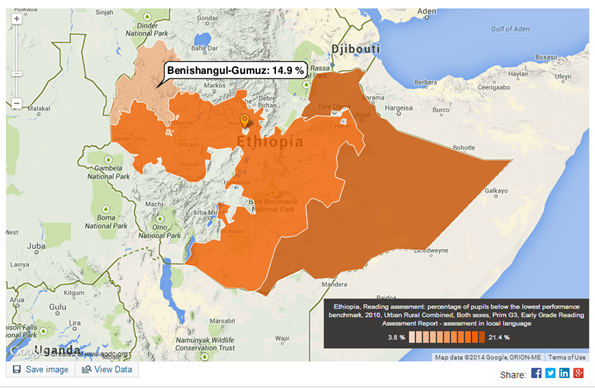You are here
EPDC Spotlight on Ethiopia
EPDC Spotlight on Ethiopia
Each week, the EPDC Data Points blog will highlight a different country and the resources we offer, such as data, country profiles, research or other tools that users have available to them through the website. In this post we highlight data resources we have for Ethiopia.
Ethiopia is a fully landlocked country in eastern Africa with a population of 96.6 million, the 14th largest in the world. Educating the 65% of the population who are below the age of 25 presents particular challenges, given the diversity of ethnic and particularly linguistic groups in the country. According to Ethnologue, there are 87 living languages present in Ethiopia today. Despite this, there has been considerable progress in providing children access to education according to official data sources, although similar to other countries in the region, the quality of instruction offered in schools varies considerably.
According to UNESCO’s International Bureau of Education, the current 8-2-2 schooling system has been in place since 1994 (8 years of primary, 2 years of lower secondary and 2 years of upper secondary). It is important to note that this is distinct from the UNESCO Institute for Statistics classification of the country’s schooling system, which classifies primary school as being only 6 years in duration. Attention to this fact should be exercised when interpreting UIS data for Ethiopia. You can read more about discrepancies arising from different data sources in EPDC’s 2013 report Out of School Children: Data Challenges in Measuring Access to Education
Learning outcomes
Students in Ethiopian schools sit for national examinations at the end of grades 4, 8, 10 and 12, as detailed in EPDC’s National Learning Assessments Mapping project. From grade 8 onward, students are expected to demonstrate mastery in subjects including English, Math, Biology, Chemistry and Physics, corresponding to 3 of the 7 domains recommended by the Learning Metrics Task Force (LMTF) as important for assessing student progress.
Among other data sources, EPDC’s database includes a 2010 Early Grade Reading Assessment (EGRA) that is representative at the subnational level. The assessment shows that for grade 3 pupils, there is great regional disparity in the percentage who are performing below the lowest reading performance benchmark, defined by EPDC as the percentage who can do nothing on the reading assessment. This number ranges from 3.8% in the capital Addis Ababa, to 21.4% in Somali. A study commissioned by USAID’s Equip II project and conducted by FHI 360 in 2010 reinforces these low learning levels, with the percentage of grade 2 or grade 3 students unable to read a single word ranging from 0% to 75% depending on the school. You can learn more about EPDC’s learning outcomes data sources through the About EPDC Data section of our website.

Education data: A snapshot
The progress that has been made in enrolling larger numbers of children in school is reflected in EPDC’s projections for the country up to 2025. Gross intake and enrollment rates are expected to decrease after peaking at well above 100% in recent years. However, completion of primary schooling and transition rates to lower secondary are expected to increase at a much slower rate; in 2015 for example, the primary completion rate is expected to range between 60-70% for both boys and girls, and this is substantially lower at the lower secondary level. While the quality of schooling in Ethiopia deserves renewed focus, much work needs to be done to ensure that all students are able to complete a basic cycle of 8-10 years of schooling, regardless of background.
EPDC’s data collection for Ethiopia also includes indicators calculated from Demographic and Health Survey (DHS) data for 2011. Among other findings are enormous disparities in enrollment by household wealth quintile at the lower secondary level. As can be seen below, net enrollment at the lower secondary level is roughly 35% for children from households in the richest wealth quintile, but less than 10% for the remaining quintiles. Policy implications for such stark inequalities could include conditional cash transfer (CCT) schemes which seek to provide incentives for families to enroll children in school, although in countries with a history of chronic food insecurity such as Ethiopia, it is important to tailor such interventions so that they will be most effective.
_9_2.png)
Education in conflict affected environments
EPDC authored a background paper for the 2011 Education for All Global Monitoring Report, The hidden crisis: Armed conflict and education, looking at sub-national disparities in school enrollment between conflict-affected and non-conflict regions. The regions of Tigray, Oromia and Somali were chosen based on a recent history of conflict. Data from DHS surveys conducted over the time period analyzed show the three conflict regions to have lower secondary attendance rates than most other regions in the country, suggesting the conflict there was associated with lower schooling outcomes. This is reinforced by findings across all 19 countries analyzed, which show weighted primary net attendance rates 11 percentage points lower in conflict regions than in non-conflict regions. More information on education and conflict can be found on the EPDC Data Points blog.
Among other data sources, unique EPDC data collections for Ethiopia include indicators published by the Ministry of Education (2006-2011), Central Statistical Office (2003-2008), indicators calculated by EPDC using DHS household survey datasets (2011, 2004-2005, 1999-2000), indicators derived from UIS data, and learning outcomes data (EGRA 2010).

Add new comment